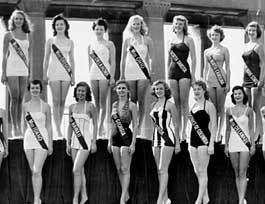Published January 23, 2002 at 4:00 a.m.
You’d think the executive producer of a documentary about the Miss America pageant would relish a moment in the spotlight. Lola Van Wagenen, a 62-year-old resident of Charlotte, guided the project, which premiered at the Sundance Film Festival earlier this month and will be broadcast nationwide on PBS January 27. But she has a valid reason for feeling awkward in the media glare. Van Wagenen is the ex-wife of actor/director Robert Redford, a tagline that makes her rather nervous. “I’ve tried to be a very private person with a very private life,” she says.
For the past two decades, Van Wagenen has been busy carving out her individual identity and destiny. In doing so, she became fascinated with American history as an undergraduate at Goddard College in Plainfield during the early 1980s. This field was later the basis for two advanced degrees, an education that is paving the way for the cinematic exploration of some remarkable female legacies. Miss America is the first in a planned series on women’s history.
The film traces the perennial allure of the televised pageant, an 80-year-old cultural touchstone that entrances some, offends others and provides a few good laughs for those who see it as pure kitsch.
“It’s far more complicated than we might think,” suggests Van Wagenen, seated at the desk of her tidy downtown Burlington office. “The pageant has sometimes been one of the few mechanisms for success open to an array of women in the 20th century. Our film shows the whole spectrum of women’s experiences.”
The spectrum of Van Wagenen’s experiences include a 1985 divorce from Redford after a 27-year union that produced three children. Asked about this, she is silent for moment. The afternoon sun coming through the window illuminates her straight blonde hair, tied back in a knot that allows random wisps to escape. She sighs.
“I was just 19 when we married,” says Van Wagenen, who is willing to outline no more than the basics. “I met him in California, where we happened to live in the same apartment building. He was an unknown, struggling young visual artist then…”
Her voice trails off, allowing a listener to connect the dots of Redford’s career arc, from bit-player on Broadway to movie idol in five years. “He went from real obscurity, but it didn’t happen overnight and we always kept a low profile,” Van Wagenen explains. “We spent a lot of time in Utah, always lived in New York, never in California.”
She had a keen desire to keep personal matters out of the headlines. So has her ex-husband. The man who played Butch Cassidy to Redford’s Sundance Kid, Paul Newman once famously observed that his costar “makes the Sphinx look like a blabbermouth.”
Miss America is the sole reason Van Wagenen has decided to carefully navigate the treacherous terrain of notoriety. But the road stretching from the Rockies of her native Utah to the Green Mountains of Vermont is an interesting one, even without the Redford intersection.
Van Wagenen is the oldest of six children in a Provo family — her father ran a small radio station — with strong Mormon roots. “All of my ancestors were polygamists,” she acknowledges. But the wives were also “very independent-thinking women… My grandmother Van Wagenen was an active Democrat. She was a delegate to the convention that nominated Franklin Delano Roosevelt for president.”
After briefly attending Brigham Young University, Lola Van Wagenen found that her academic pursuits took a back seat to marriage to Redford and subsequent parenthood. In 1968, she worked in the anti-war movement, specifically with Another Mother for Peace. Two years later, the emergence of Earth Day prompted her to launch Consumer Action Now. “It was aimed at housewives,” Van Wagenen says. “The idea was to teach people how their buying habits affect the environment.”
When she and Redford separated in the late 1970s, Van Wagenen decided it was time to resume her studies. “My son and daughter both went off to college, and I thought, ‘I really want that.’ I wanted to find a way to be more effective. I had taken some classes, but could never put a whole program together. So, I dropped everything else to do it. I was driven to do it. The Mormon culture puts a lot of emphasis on education.”
Goddard beckoned. “There weren’t that many adult-degree programs in the country then,” she says of the arrangement that allowed her to do course work at home in Manhattan, spending just 10 days twice a year on the Plainfield campus. Peace activist Dave Dellinger, of Chicago Seven fame, was her senior advisor.
“The college was perfect for someone like me, who carried a lot of baggage,” Van Wagenen theorizes. “It’s a place that gives you a sense of who you are and an excitement about learning.”
That excitement carried her through a master’s degree and Ph.D. at New York University — both in American history. Van Wagenen’s religious roots merged with her feminist views for a 1995 dissertation about a coalition of eastern suffragists and Utah’s Mormon women in the late 19th century.
By the mid-1990s, Van Wagenen was dividing her time between an Upper East Side apartment and a lakeside home on the Charlotte-Shelburne town line that she had owned for more than a decade. For the past 15 years, Van Wagenen’s “significant other” has been George Burrill, president of the Burlington-based Associates in Rural Development.
Her children are grown: Now 41, Shauna lives in New York with husband Eric Schlosser, author of the best-selling book Fast Food Nation. An artist, she runs her father’s Sundance line of environmentally friendly products. Amy, 30, is an actress married to a photographer, also based in the Big Apple. James, 39, is a California filmmaker. The Kindness of Strangers was his 1993 look at the issue of organ transplants. He’s currently working on a feature screenplay called Spin with Middlebury businessman and author Don Axion.
After graduating from NYU, Van Wagenen began to contemplate “the variety of ways to use history in the public arena. When I thought about teaching, I was overwhelmed by the notion of what an incredible commitment that would be. I have so much respect for teachers, but I began looking for ways to use history that better suited my skills.”
Her next step was influenced by a documentary about a Japanese-American brigade in World War II that she had seen in an NYU course. “It used history and storytelling in an incredible way,” says Van Wagenen. “That inspired me.”
In the fall of 1996 she and an NYU classmate started a film production company. Named for the Greek muse, Clio Inc — Visualizing History creates CD-ROMS, interactive kiosks, Web sites, exhibits, films and videos. Two Vermont women are on the company’s advisory board: Julia Alvarez, the novelist and Middlebury College English professor, and University of Vermont associate history professor Melanie Gustafson.
The idea for the Clio’s documentary division, dubbed “American Originals: Women in Popular Culture,” came out of a 1997 retreat for historians Van Wagenen organized in Vermont. Miss America is the “maiden” voyage on a long list of projects. Future films will explore women photographers, dancers, comediennes and blues and country musicians.
Six months after Clio got off the ground, Van Wagenen founded the History Institute for Media and Education. “It’s a not-for-profit organization that does all of the development, fundraising and conceptual work,” she explains. “Clio is the production arm.”
Directed by Lisa Ades, Miss America employs archival footage, interviews with former winners and several other “talking heads.” Alvarez is one, Ms. magazine founder Gloria Steinem another. They offer their perspectives on the often-turbulent beauty pageant that began as a promotional gimmick to keep tourists in Atlantic City after Labor Day.
Ades credits UVM, which she attended from 1982 to 1984, with introducing her to film. “I took a… theory course and was completely smitten,” she says. “I also did some video work during an internship at Vermont ETV,” now known as Vermont Public Television.
Miss America has an additional Vermont connection: Sarah Kramer, the associate producer, is a 1996 Middlebury College graduate.
Even when Ades transferred to NYU film school in her junior year, she continued to spend summers in the Queen City. After graduation, she found a job as producer of public-affairs shows at a PBS station in Manhattan. In 1989, she began a 10-year collaboration with documentarian Ric Burns — brother of Ken — that culminated in his recent New York series on PBS.
The idea of directing Miss America, co-produced by her own Orchard Films in lower Manhattan, sounded perfect to Ades, who met Van Wagenen in 1996. “I immediately knew beyond a shadow of a doubt it would be a really unique and interesting way to look at women’s history,” she recalls. “A good subject jumps out at you.”
During her childhood, watching the pageant was “an annual family ritual,” says Ades, now 37. “You rooted for your favorite contestant. I always thought Miss California would win, though. She was usually blonde, with blue eyes. I figured this must be what the ideal American woman should look like.”
Van Wagenen’s recollection of the pageant is even more specific. “When Miss Utah, Colleen Hutchinson, won in 1952, I remember how proud we were as Mormons,” she says. “We felt like a minority.”
Miss America is straightforward chronology rather than attack journalism. The documentary’s even-handed approach might alienate die-hard feminists, but the pageant organization gave its blessing. That allowed the filmmakers crucial access to the archives and permission to shoot the 1998 pageant in Atlantic City, the New Jersey resort town that has always hosted the event.
Ades knew the film’s subject matter would be “highly controversial… Beauty pageants denigrate women. But I didn’t know how nuanced and surprising the contestants’ stories would be, or how compelling the Miss Americas are. They’re so smart, so funny and sometimes irreverent.”
In 1927, the fledgling Miss America contest went on hiatus for about six years after being condemned by conservatives who felt it was perverted. In 1968, feminists outraged by the pageant’s sexism picketed outside the auditorium, even burning emcee Bert Parks in effigy. “Girls in bathing suits are highly problematic,” Ades acknowledges. “In the early days, the display of the female form drew protestors from the right. Then, jump ahead 40 years and they’re protesting from the left.”
To prove that Miss America was in tune with the changing times, the entertainment got downright silly in the early 1970s: “Call Me Ms.” was an absurd song-and-dance routine performed by prancing babes in mini-dresses.
“There is a natural humor and irony inherent in the pageant,” Ades says. “We had no interest in poking fun. That would be mean-spirited. What’s the point? Instead, we see through the lens of Miss America itself.”
Parks was the ever-present master of ceremonies for a quarter century, beginning in 1955. He crooned the familiar theme song, danced, chatted with the contestants, cracked jokes and constantly mugged for the cameras. On a show in the early 1960s, one pretty little thing tells him that women are “too high-strung” to qualify for the presidency. Another purrs that her gender’s place is “in the home.” There she is: Miss America.
The documentary examines the 1945 saga of Bess Myerson, the first Jewish Miss America. When officials suggested a name change for her to appear more mainstream, Myerson countered that it was important to make her parents feel proud among their fellow tenants at the Sholom Aleichem Apartment Houses in the Bronx. When the pageant’s corporate sponsors refused to hire her for their ad campaigns, she went out on the lecture circuit to talk about anti-Semitism.
The pageant actually had a rule that specified only the white race need apply. No woman of color was a contestant until 1970, and it took another 14 years for one to earn the title. Vanessa Williams, Miss America of 1984, immediately began receiving death threats and hate mail. She was asked to resign 10 months later, when Penthouse magazine announced it would publish unauthorized nude photographs of her taken two years earlier.
“Beauty is still the currency out there,” observes Julia Alvarez. Gloria Steinem’s take on the pageant is that “women compete with each other for the favor of powerful men.”
Van Wagenen believes the pageant offers a mixed message. “Be independent, but stay at home. Be smart, but only in limited circumstances,” she says. “Yet, Miss America is the biggest granter of scholarships in the world.”
Those scholarships were initiated in the mid-1940s, when public-relations wizard Lenora Slaughter was recruited to upgrade the pageant’s disreputable image. She ushered in the era of curfews, chaperones and a ban on smoking, drinking and visits from men. She also saw to it that 18 became the age requirement for contestants, who had sometimes been much younger than that.
The intention was for the show to feature wholesome young ladies strutting around the stage in glamorous evening gowns and modest bathing suits — one-piece only. Some critics charged it was still a meat market, no matter what cosmetic alterations Slaughter imposed. “The swimsuit competition is the most honest part of the pageant,” Steinem suggests, “because it really is about bodies.”
So why do women succumb? Some contestants in the documentary point to the glitter of show business or pressing financial need as their reasons for entering such competitions. Good looks and dubious talent — various contestants danced, ice skated, twirled batons, played accordion, demonstrated ventriloquism skills and jumped on trampolines over the years — could change their lives.
As early as 1926, a winner from Oklahoma who posed with products sold by the pageant’s business sponsors was able to earn $100,000 — topping the salaries of baseball legend Babe Ruth and the President of the United States.
Lee Meriwether was on the brink of poverty before she was crowned in 1955 by a panel of judges that included Grace Kelly. It was the first pageant on live TV. Meriwether is one of several personable, self-effacing Miss Americas who remain poised and beautiful in middle age. Their backstage revelations add considerable insight to the documentary.
“Even the women who protested in 1968 didn’t want to seem angry at the contestants, just the institution,” Van Wagenen notes. “In the film, we wanted to look at each woman’s saga, not bash the pageant.”
Although her ex-husband founded the Sundance festival — in Utah, which he first visited with Van Wagenen — Miss America was selected this year on its own merits. “When I told him the film had been accepted, he laughed and said, ‘You know, I had nothing to do with this,’” she recounts. “I’m not even sure my name was on the film, because we sent a copy without the credits.”
Her name is on the finished product, of course, but Van Wagenen wasn’t able to attend the Sundance event because of a previously planned vacation at a New Zealand getaway home she’s owned since 1993.
Clio received grants from the National Endowment for the Humanities, and PBS will air the beauty pageant documentary on “American Experience,” a program devoted to historical issues. It will be a bit of a departure for the program, according to Van Wagenen. “They used to do history and stay there,” she notes. “They never would come forward into the present time, as we have. This documentary is more immediate.”
Ades says that working with Van Wagenen was a pleasure. “Lola is incredible. I adore her. And I’m grateful for her giving me the opportunity. I can’t think of a juicier project, to come together as historian and filmmaker; to come at it from different perspectives, yet very much on the same page. We made the documentary we both wanted to make.”
Van Wagenen agrees. “As we explained to the Miss America people, ‘We’re just here to tell a good story,’” she says. “‘And have a little fun.’”
Miss America will air on Vermont Public Television’s “American Experience” Sunday, January 27, at 9 p.m.
More By This Author
Speaking of Film
-

A New Film Explores Vermont’s Unsung Modernist Buildings
Mar 20, 2024 -

A Film Critic Pays Final Respects to the Palace 9
Nov 11, 2023 -

Director Jay Craven Wins 10th Annual Herb Lockwood Prize
Oct 21, 2023 -

Book Review: 'Save Me a Seat! A Life With Movies,' Rick Winston
Aug 30, 2023 -

Steve MacQueen Named Executive Director of Vermont International Film Festival
May 22, 2023 - More »
Comments
Comments are closed.
From 2014-2020, Seven Days allowed readers to comment on all stories posted on our website. While we've appreciated the suggestions and insights, right now Seven Days is prioritizing our core mission — producing high-quality, responsible local journalism — over moderating online debates between readers.
To criticize, correct or praise our reporting, please send us a letter to the editor or send us a tip. We’ll check it out and report the results.
Online comments may return when we have better tech tools for managing them. Thanks for reading.












































